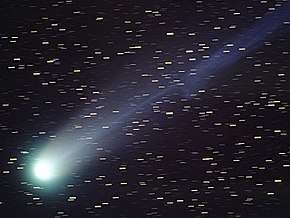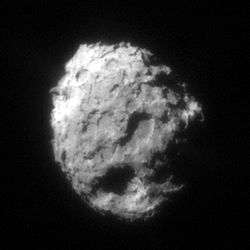178P/Hug–Bell
178P/Hug–Bell is a periodic comet in the Solar System. It was discovered by Northeast Kansas Amateur Astronomers' League members Gary Hug and Graham Bell and is thought to be the first periodic comet to be discovered by amateurs. It was declared a comet less than two days after its initial discovery, after having its course confirmed on previous images.[3]
| Discovery | |
|---|---|
| Discovered by | Gary Hug and Graham E. Bell |
| Discovery date | December 10, 1999 |
| Alternative designations | 1999 X1, 2006 O1 |
| Orbital characteristics A | |
| Epoch | July 7, 2013 |
| Aphelion | 5.405 AU |
| Perihelion | 1.9337 AU |
| Semi-major axis | 3.6993 AU |
| Eccentricity | 0.4730 |
| Orbital period | 7.03 a |
| Inclination | 10.9755° |
| Last perihelion | July 23, 2013[1] July 6, 2006 |
| Next perihelion | 2020-Jul-16[2] |
Hug-Bell's orbital period is about seven years; its orbit is eccentric, though less so than many comets. Hug-Bell's orbit lies entirely outside the orbit of Mars, but at its aphelion overlaps in solar distance with the orbit of Jupiter. Because it never comes closer to the Sun than about 2 AU, it is never expected to be a very bright comet, with a typical perihelion magnitude of 18-19.[4]
References
- Syuichi Nakano (2010-04-09). "178P/Hug-Bell (NK 1910)". OAA Computing and Minor Planet Sections. Retrieved 2012-02-25.
- "178P/Hug-Bell Orbit". Minor Planet Center. Retrieved 2014-06-20.
- "Winter, Jennifer and Winter, Vic. Comet Hug-Bell Discovery!". ICSTARS Astronomy. Archived from the original on 19 October 2006. Retrieved 2006-10-18.
- "178P/Hug-Bell (1999)". Seiichi Yoshida July 21, 2006. Retrieved 2006-10-18.
External links
- Orbital simulation from JPL (Java) / Horizons Ephemeris
- 178P/Hug-Bell – Seiichi Yoshida @ aerith.net
- 178P/Hug-Bell @ JPL Small-Body Database Browser
| Numbered comets | ||
|---|---|---|
| Previous 177P/Barnard |
178P/Hug–Bell | Next 179P/Jedicke |

